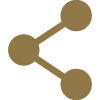(Macro)Molecular Crowding
Life of the Pottage
Springer
ISBN 978-3-032-03369-7
Standardpreis
Bibliografische Daten
Fachbuch
Buch. Hardcover
2025
15 s/w-Abbildungen, 67 Farbabbildungen.
Umfang: 548 S.
Format (B x L): 16 x 24.1 cm
Gewicht: 978
Verlag: Springer
ISBN: 978-3-032-03369-7
Produktbeschreibung
However, the effect of such a complex crowded environment on the behavior of biological macromolecules is poorly understood. This is because most of the biomolecular research in vitro is traditionally conducted in dilute solutions, which by no means can be considered adequate models of the extremely crowded intracellular space. To overcome these issues, multiple approaches are being developed to mimic macromolecular environments and to investigate biomolecules under these conditions of artificial crowding and confinement.
Importantly, recent years revealed that the distribution of macromolecules within the intracellular space is highly inhomogeneous; i.e., macromolecular crowding is characterized by the remarkable spatio-temporal heterogeneity, where one can find various membrane-less organelles and biological condensates representing overcrowded liquid droplets. The biogenesis of these highly dynamic cellular entities is driven by the liquid-liquid phase separation, and their formation typically represents a cellular response to the changing environment. These observations opened multiple new directions for a better understanding of the complexity and peculiarities of the cellular molecular kitchen.
This book aims at providing foundational information on these and related topics, which will be delivered by world-leading specialists in corresponding fields. By having chapters spread across all key foundational elements that come together in this field of study, this book will be the go-to reference in the area. It will provide guided access to the appropriate primary and secondary literature of this very exciting field. It also will provide a description of the physics of the process, give experimental guidance regarding the characterization of these phenomena, and show examples of well-understood systems. The book will provide a guide that will allow readers to rapidly form hypotheses and design experiments on their proteins or study system.
This book will help researchers to understand the relevant findings and help them to navigate through the clutter. Early career researchers as well as researchers coming from different fields need a basic reference to introduce them to this area and help them become productive and progress with their research faster.
Autorinnen und Autoren
Produktsicherheit
Hersteller
Springer Nature Customer Service Center GmbH
Europaplatz 3
69115 Heidelberg, DE
ProductSafety@springernature.com

 BÜCHER VERSANDKOSTENFREI INNERHALB DEUTSCHLANDS
BÜCHER VERSANDKOSTENFREI INNERHALB DEUTSCHLANDS











